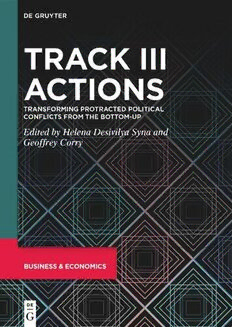
Emerging Trends in Conflict Management. Volume II Track III Actions: Transforming Protracted Political Conflicts from the Bottom-up PDF
278 Pages·2023·5.116 MB·English
Most books are stored in the elastic cloud where traffic is expensive. For this reason, we have a limit on daily download.
Preview Emerging Trends in Conflict Management. Volume II Track III Actions: Transforming Protracted Political Conflicts from the Bottom-up
Description:
Since the end of the Cold War in the early ’90s, a multi-track approach to peacemaking has been developed by academics and practitioners to bring political and civil society leaders together from across the divide of contested societies to find ways out of the conflict. Much of the focus up to now has been given to the strategic contribution of Track II conflict analysis and problem-solving workshops. This book puts the spotlight on the role that grassroots leaders and citizens can play at Track III level in the community in building and strengthening a bottom-up approach to conflict transformation following protracted conflicts. In Part 1, the focus is on the post-conflict situation of Northern Ireland twenty years after the Belfast Good Friday Agreement. Part 2 portrays scholarly and practitioners’ perspectives and actions in communities and organizations designed to build partnerships in order to counteract the legacies of active protracted conflict. Plots the role of Track III approaches within a multi-track peacemaking pyramid in the protracted conflict and post-conflict phases of confl ict transformation. Provides case studies on how to engage community leaders in thinking together how to work with deep-seated legacies of protracted conflicts. Explores the contribution of bottom-up models to build intergroup partnerships within and between local communities. Focuses on the interface between research and practice. Highlights the role of Track III in active conflict and post-conflict phases of conflict transformation Illustrates how to engage community leaders to work with legacies of protracted conflicts Underscores the research-practice interface
See more
The list of books you might like
Most books are stored in the elastic cloud where traffic is expensive. For this reason, we have a limit on daily download.
